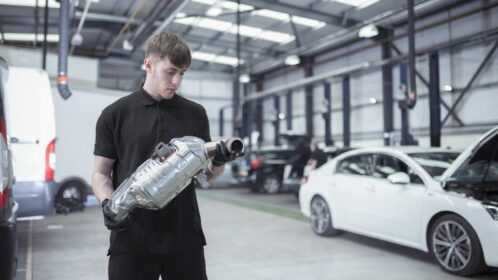Does Insurance Cover Catalytic Converter Theft: Is a stolen catalytic converter covered by insurance? If you have comprehensive coverage in your auto insurance policy, you are generally covered against catalytic converter theft. Comprehensive coverage generally pays to replace the stolen catalytic converter and repair any damage associated with its removal.
Does Insurance Cover Catalytic Converter Theft?
Does insurance cover catalytic converter theft? Your insurance generally covers catalytic converter theft if your auto policy includes comprehensive coverage. Comprehensive coverage covers the cost of replacing a stolen catalytic converter and damage caused by theft. However, not all comprehensive coverage policies are created equal, so it’s best to make sure your policy protects you from theft, hopefully before a theft happens!
What is a catalyst?
A catalytic converter is an important car part that reduces harmful emissions. It has been a mandatory part of all petrol cars since the 1975 model year and is located between the engine and the muffler on the underside of the vehicle. It consists of a ceramic honeycomb coated with metals (usually platinum, rhodium, and palladium) that allows hazardous substances in car exhaust to recombine into safer gases. For example, carbon monoxide, a poisonous gas, enters the converter, mixes with oxygen, and leaves it as carbon dioxide.
Why do people steal catalytic converters?
The metals used in catalytic converters are quite valuable and can be easier to steal due to their exposed location on the underside of a vehicle. It only takes a thief a few minutes to steal a catalytic converter, so multiple catalytic converters can be stolen in a relatively short time. This combination makes catalytic converters a popular target for thieves.
It only takes a thief a few minutes to steal a catalytic converter.
Which cars are most prone to catalytic converter theft?
Any gasoline-powered car made after 1975 can be a target, but the main vehicles for catalytic converter theft are usually older cars because they have a higher amount of valuable metals in their catalytic converters. The technology wasn’t as refined for older cars, so their catalytic converters may contain more metal than newer ones. However, newer cars can have metals in better condition because the converters have not undergone as much wear and tear. Hybrid cars can also be favored by thieves because their catalytic converters are used much less than standard cars, resulting in a metal that is easier to salvage.
Perhaps even more important than the age and condition of the vehicle is the style and construction of the bodywork. Any car with a high ground clearance (such as an SUV) is a more popular car for catalytic converters theft because it is easier to get under the vehicle and reach the inverter. The way the converter is installed can also make a difference. Some automakers install the converter with bolts, while others weld it in place. Bolt-on converters are easier to steal, so concerned owners should check how their converter is connected.
List of cars most attacked by catalytic converter theft?
The cars most targeted by stolen catalytic converters in the past three years are:
- Ford Ecoline
- Ford f-250
- Ford
- Honda agreement
- Honda CRV
- Toyota Prius
- Toyota Tacoma
- tundra
- Toyota Sequoia
- Lexus SUVs
- Hybrid cars
Many thieves target tall cars such as SUVs and trucks because they are easier to access. If you own one of these cars, you may want to read on to learn how to take extra precautions to keep your car safe.
How much does it cost to replace a stolen catalytic converter?
Replacing a stolen catalytic converter costs a lot more than what junkyard thieves get. On average, with parts and labor, the cost can range from $900 to $3,000. The actual cost will depend on how much your insurance covers, your mechanic, and your vehicle type. Since catalytic converters are the last line of defense against dangerous exhaust fumes, you should replace one very quickly if it were stolen.
How do I know if my catalytic converter has been stolen?
If your vehicle has been attacked, there are some obvious signs to look out for. When you start the car, it can be much louder than usual because a stolen catalytic converter disconnects the muffler. The vehicle will also appear less responsive than usual and will have no acceleration. You may also notice a foul odor from the dirty exhaust now coming out of the vehicle. You can confirm the theft of the catalytic converter by looking under the car for an obvious hole in the landing gear near the muffler.
If you notice that your catalytic converter has been stolen, take your car to a mechanic right away. Consider calling a tow truck as driving without the converter can be dangerous.
How to prevent the theft of catalytic converters?
There are measures you can take to protect your vehicle from catalytic converter theft. Preventive measures include:
- Park near a wall with the exhaust pipe closest to the wall. That makes it more difficult for a thief to get to the catalytic converter.
- If you have multiple vehicles, park the vehicles with lower ground clearance than away from vehicles with higher ground clearance (such as SUVs).
- Consider etching your converter with the car’s VIN to make it easier to trace.
- If you have a car alarm, set it to respond to vibrations.
- Consider installing a catalytic converter. This cage-like device is installed around the converter, making it more difficult and time-consuming to access and steal.
What theft prevention measures can I take?
Considering how common catalytic converter theft is, you’ll want to do everything you can to prevent yours from ending up on the black market. There are some easy ways to prevent theft of your vehicle’s catalytic converter.
To steal it, the converter must be easy to remove and the thief must have the opportunity to be alone with your car for a few minutes.
A mechanic can install aftermarket theft protection for catalytic converters for a fee. This anti-theft device makes it more difficult to remove the converter and usually comes in the form of a shield or cage. If your mechanic doesn’t have one on hand, your local auto parts store can hook it up. (Although such devices help prevent theft, the installation costs are usually not covered by your car insurance.)
You will also want to remember to leave your car in safer places. The police advise parking in closed garages as much as possible. If that’s not feasible, try parking in a well-lit or busy area, or one with security cameras, as a theft prevention strategy; this way, thieves have no chance of removing your converter undetected. Avoid leaving your ride in parking lots designed for commuters; Thieves know that cars will be left unattended all day and may plan to hit a large number of vehicles at once.
Some car owners will also have the vehicle identification number engraved on the catalytic converter so that if the inverter is stolen, it can be returned to them after an attempted resale.
Which theft prevention measures should I not take?
Don’t do nice things like stick a note on your catalytic converter that says “I know you want my sweet precious metals, but please don’t be a jerk.” The success rate of this tactic is less than 1.1%.
It is also not advisable to park your car in an abandoned spot and then wait under the chassis with a crowbar in hopes of catching a catalytic converter in the act.
Conclusion – Does Insurance Cover Catalytic Converter Theft?
Does insurance cover catalytic converter theft? It depends. If you only have liability coverage, or liability and collision coverage, your policy will not cover the theft of your catalytic converter.
However, if you have comprehensive insurance, the theft of a catalytic converter will be covered by your policy. But keep in mind that even if your policy covers catalytic converter theft, you’ll have to pay your deductible.
If you suspect that your catalytic converter has been stolen, first contact the police to report the theft, then contact your insurance company and file a claim. If you have comprehensive coverage on your policy, the loss is likely covered. Do not attempt to drive your vehicle until you have spoken to a qualified repair shop. They can advise you to take it to the repair center or to tow the vehicle.







